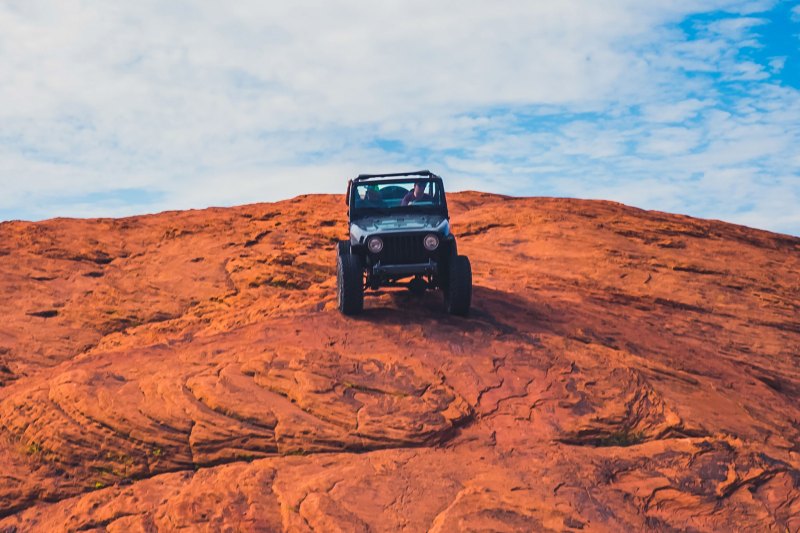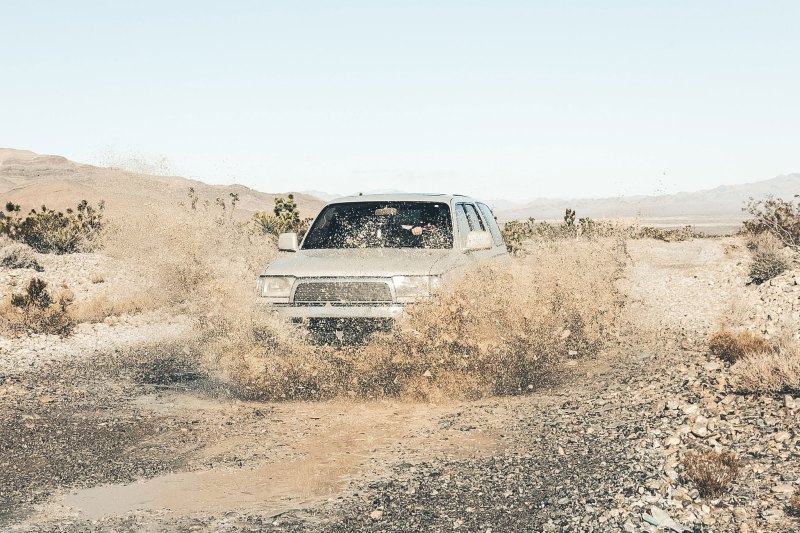
When the urge to explore arises, few drivers ever find their way off the pavement. And really, they don’t have to; the most popular U.S. campsites, landmarks, and panoramas can be accessed via roadway. But to access more original vistas and tell more compelling stories, you’ll need to go off-road.
Thankfully, doing so is easier than ever. No longer do you need to sink years of effort into modifying your rig; several automakers will happily sell you a brand-new vehicle with more off-road goodies than you’ll likely ever need. And if you still prefer to do your own modifications, the aftermarket community is packed with options at all price levels.
In this article, we’ll cover the basics of off-roading, because whether you have a crossover or a Jeep Gladiator Rubicon, you can explore far more than a fire road with the right equipment and fundamentals.

What you’ll need to go off-roading
Whether your vehicle is old, new, or two- or four-wheel drive, here are some essentials to equip yourself with before you hit the trails:
Tires
Just like some people believe all-wheel drive will magically cure wheel slip in the snow, others imagine a transfer case or locking differential will overcome any tire inefficiencies off-road. Unfortunately, if you attempt to drive across mud, rocks, or sand in summer tires (or worse, balding or cracked ones), you’re asking for trouble. Different tires are specifically developed to handle different environments.
A mud-terrain (M/T) tire will make some noise on the road, but it will also eject mud, snow, or sand quickly to help you coast through the mucky, loose stuff. Similarly, if you live in a snowy area, it would be safer if you use the best snow tires on your off-road vehicle.
An all-terrain (not to be confused with all-season) tire is another good choice for those who expect to encounter a wide variety of surfaces, but likely aren’t planning to do anything too hardcore. Size your tire according to what fits and turns easily in your vehicle’s wheel wells. Larger tires provide more ground clearance and a bigger contact patch, but if you go too big, you’ll need to re-gear your axles or transmission to avoid power loss and poor fuel economy.
Recovery gear
A good set of tires will help keep you out of trouble, but if you get stuck, you’ll be thankful for recovery gear. Among the must-haves are MaxTrax traction pads to help you extract and plow through loose terrain, snatch straps to attach to another vehicle’s recovery points and pull you from a snag, a high-lift jack, and base to elevate your rig and change a tire on any terrain.
Additionally, you need a patch kit to cover a tear in your tire temporarily, a shovel to, uh, dig yourself out of trouble, work gloves to save your fingers and palms, a headlamp or other light source to illuminate the issue (which often happens during the inconvenience of night), and a jump starter to overcome a dead or faulty battery. You can get fancy with equipment like winches, but keep in mind that these carry a hefty weight penalty (not to mention expense) and aren’t necessary for the average off-roader.
Lights
We’ve all seen the weekend warriors with about thirty LED, halogen, and HID lights pointing in all directions. That doesn’t need to be you (and unless you have a very specific use case, it shouldn’t be you). Really, all you need is a good set of driving lights that cast a wide enough beam far enough into the night. If your stock headlights aren’t cutting it, an easy solution is to attach a set of auxiliary driving lights to your front bumper with a switch wired somewhere on your dashboard.
If you want to go the extra mile, consider a set of spot/search lights that can be mounted near your door mirrors to illuminate the left and right sides of a path ahead. Yes, LED light bars look cool and can be useful, but they can also create problems if incorrectly mounted (think intense glare off your hood), so be sure that’s what you want.
Emergency gear
The tires didn’t keep you out of trouble and the recovery gear couldn’t free you from it – now what? Plan and prepare for these emergency situations before the fact. If you’re overlanding or headed to a campsite, chances are that you packed sufficient food and water for a couple of days, but if not, you’ll always want some rations and water stashed on board. Bundled with these essentials should also be a set of warm, waterproof clothes (yes, even if the weather report is favorable).
In the event of a rollover or similarly dangerous predicament, you’ll want a seatbelt cutter or glass breaker somewhere on your person or easily accessible. Of course, a first-aid kit is a must. And if you’d rather not wait until you’re found, it’s a good idea to buy a long-distance radio with a spare battery to alert anyone nearby. If you’re driving in snow, you will also need snow tires, an ice scraper, and a roadside emergency kit.

What does what
Depending on your vehicle, the driver’s seat can give you access to a vast array of switches, buttons, and levers, inviting the question: What do you activate, and when?
Traction control
Whether you have two-wheel drive, all-wheel drive, or four-wheel drive, if your vehicle was made in the last decade, it probably has some form of traction control. The most basic iteration of this is a simple on/off setting, but vehicles designed to tackle various climates and terrain will come equipped with multiple configurations that adjust throttle mapping, braking, and/or power distribution to limit wheel slip and therefore overcome obstacles. If you have an on/off switch, your best bet is to keep the system off when you’re off-road – this will prohibit the vehicle from applying the brakes at the first hint of traction loss. If your system has multiple settings, do a bit of homework via YouTube videos, forums, or your user manual to see what setting is best in which conditions.
4WD high vs. 4WD low
If you do have a 4WD vehicle with a two-speed transfer case (4WD Hi and 4WD Lo), you’ll need to know how and when to move between these settings. For most vehicles, the transition happens via an additional lever somewhere in the center console area, but for some, it’s a knob mounted on the dash. If your vehicle has permanent 4WD (and therefore doesn’t have a 2WD setting), you’ll want to keep it in 4WD Hi to drive on the highway or tackle terrain where you’ll need to maintain momentum (i.e. mud, sand, or snow). 4WD Lo, meanwhile is used when you’ll need as much torque as possible at low speeds (i.e. rock crawling). Once you’re in the 4 Lo setting, you’ll also want to use the right gear; the lower the gear, the more torque available.
Locking differentials
A two-speed transfer case (4WD) system will take you much further than an all-wheel drive or two-wheel drive setup, but if you really want to move through just about anything, you’ll want locking differentials. With an open (not locked) differential, each wheel on an axle spins independently, meaning if one tire doesn’t have any traction and is therefore spinning helplessly, you simply lose all the power that would otherwise go to that wheel. By locking a differential (typically via a button or switch somewhere on the dashboard), you forcibly link the two wheels — so if one gets loose, that power is distributed to the wheel with traction. Power + traction = progress.

What you might want for off-roading
These aren’t absolute essentials to basic off-roading, but are useful extras for off-roading 101: What you should know before you go for more serious wheelin’.
Air compressor
After airing down for improved traction off-road, a good-quality air compressor restores your tires to standard psi (a number you’ll find in your manual or on the tires themselves). It can also be used after a puncture to inflate a tire before applying a patch. These systems come in all shapes, sizes, and price segments. More expensive compressors will have higher CFM (cubic feet per minute) ratings, meaning they funnel more air into each tire in a given minute. Lower CFM compressors will take some time to refill air but are often lighter and cheaper.
Even if you don’t personally own an air compressor, but you’re planning to tackle off-road terrain that will require an air down, make sure you travel with someone who has one.
Suspension
A large segment of the aftermarket is dedicated to the combination of shock and spring that settle between your vehicle and its wheels. Consider that a good suspension is intended to support the weight of your vehicle with the right spring rate and shock valving. Too low a setting for either will mean bottoming out over every bump; too high a setting will create a punishingly stiff ride for all vehicle occupants. When deciding which suspension is right for you, speak with the manufacturer. Specialists will tailor their advice based on your tire size, weight-adding equipment, and intended use case.
Snorkel
A snorkel is a way of re-routing your air intake from engine height to a position much higher on your vehicle. The only purpose for this system is to give you an off-roader image … no, not really. Routing your air intake higher on your vehicle can serve two purposes: in situations where you are fording water at or above your grille level, a standard intake would suck that water into your engine. Instead, the snorkel takes fresh air from above the surface.
Alternatively, if you spend a lot of time in loosely packed dirt, you may clog your air filter with the cloud of dust that hovers at window height (especially so if you are following other vehicles). In this case, a snorkel will pull cleaner air from above the dust cloud.

Tips for driving off-road
On one end of the spectrum are people who assume that because they don’t have 4WD, they don’t belong off pavement, while on the other end are folks who attempt to rock crawl in a Toyota Prius (don’t roll your eyes — I’ve seen it). There is a happy medium, though. Even if you bought the two-wheel-drive version of a vehicle with good ground clearance, proper off-roading techniques and equipment (see above) will get you pretty far.
On the other hand, if you’re rocking a Prius, you should probably just find a friend with a truck.
Stay within your limits and bring a buddy (ideally in another vehicle)
These are two separate pieces of advice, but linked together, they are the most important words of wisdom we can impart. First, remember that if you exceed your limits and do damage to your vehicle or yourself, you won’t have an opportunity to get back off-road for a while. Even if you’ve made the trek down a trail, only to find an obstacle you aren’t comfortable with, it’s better to turn around than to wind up in a dangerous and/or expensive predicament. This is also where your buddy comes in. While you can make a bad call alone, you’re less likely to do so with someone else (smart) weighing in.
If you both decide to go for it, your buddy can also serve as a spotter to safely guide you over or through an obstacle. And, if this buddy came with their own vehicle, they can either pull yours out of trouble or pull you out of an overturned or otherwise damaged rig (which is harder to accomplish when they’re strapped into the seat next to you).
Airing down
If your stock vehicle is set up to go off-road, or if you’ve invested in a good set of AT or MT tires, you’ll likely notice that there’s tread not only where you’d expect it, but also on the sidewalls of each tire (called biting edges). It isn’t there for show. Before you get into the thick of off-roading, you can optimize traction by airing down each of your tires to between 20-25 psi. This will put more of your tread (including the biting edges) in contact with the ground. More tread means more grip, and without as much air in the tire, its shape can change based on the surface. This allows the tire to dig into rocks or mud, pulling the vehicle forward.
Used a different way, airing down on deep mud or snow improves your “float,” letting your vehicle cruise over the top of the ground rather than sinking into it. And when the off-roading fun is over, don’t forget to air your tires back up with a compressor so you don’t kill your fuel economy on the highway or worse – unseat the tire from its rim.
Check the depth
Even if you’ve gone to the trouble of fitting a snorkel to your vehicle, that doesn’t mean you can magically make it across any body of water. If you wander too deep, or into a fast enough moving current, you run the risk of flooding your car or being carried down river (potentially upside down). Do yourself a favor and check the water’s depth at the deepest point to make sure you aren’t heading into a disaster.
Learn how to drive during winter
Driving in snow or ice can be dangerous, especially if you go on an off-road path. Seriously, if you have no experience, don’t attempt to do it until you’ve practiced in a controlled environment to a point where you’re confident. If you have an AWD off-road SUV or truck, it should be easier for you to drive in the snow — but that shouldn’t give you false confidence. For starters, you need to learn how to brake and turn and accelerate smoothly while feeling the traction in your tires.
If you’re approaching a hill, you should gradually increase the momentum so you don’t lose traction, but if you’re driving downward, you can take your foot off the gas pedal. And if you’re skidding, the trick is to keep off the accelerator without stepping on the brakes until you regain traction. Of course, you need to know how to survive a road trip breakdown in the dead of winter.
Know your vehicle
If you’ve spent time daily driving your vehicle, you understand some of its characteristics like turning radius and fuel economy, but off-roading requires deeper knowledge. Approach, departure, and breakover angle deal with the level of clearance you have beneath your front and rear bumpers, and the space between axles. Off-road, retaining a mental picture of the space beneath each of these sections of your vehicle will help you avoid getting stuck on rocks, inclines, or ruts that you should have taken at an angle (or skipped entirely).
Editors' Recommendations
- Here’s how to live in your car comfortably for a few weeks (or longer) like a pro
- These are the questions you should always ask before buying a car
- Watch: Simulations of cars crashing at different speeds show when things get deadly
- Save money on gas with these fantastic fuel rewards apps
- Road trip tips: Travel with one of the best ultralight travel trailers





